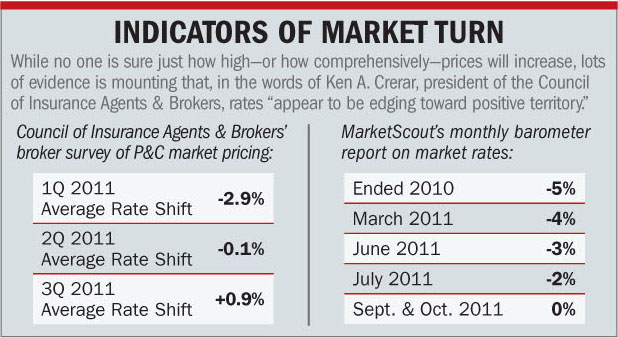 After a year of near-record catastrophe losses, increasing combined ratios and highly disappointing investment yields, the natural expectation is that insurers looking to stabilize their books have but one choice: to raise prices.
After a year of near-record catastrophe losses, increasing combined ratios and highly disappointing investment yields, the natural expectation is that insurers looking to stabilize their books have but one choice: to raise prices.
And yes, some signs of a market hardening are becoming visible: The most recent Council of Insurance Agents & Brokers pricing survey, for example, indicated average rates in the third quarter turned positive for the first time since the end of 2003.
Also, MarketScout’s latest pricing barometer yet again showed no rate decrease, prompting its CEO, Richard Kerr, to opine, “With two consecutive months of a flat market, we are on the cusp of a composite rate increase.”
But the degree (how high will prices go?) and extent (how many lines of business will see a bump?) of the hardening is very much an open question—and plenty of factors are conspiring to keep rates constrained.
“When you look at the underlying indicators, we should be seeing more movement in rate—but we’re not seeing it,” says Alastair Swift, CEO of global placement for Willis Ltd.
What accounts for this?
Capacity, while not exactly robust, is still strong enough to maintain the market at its current state, according to some brokers and others.
“There’s still plenty of capacity in the market to dampen prices,” Ken A. Crerar, president of the Council of Insurance Agents & Brokers, said in an October statement.
And while some insurers insist that it’s high time their companies start making serious moves to boost rates, the reality—at least for many—is that cash-conscious clients could be lost if squeezed too hard.
“While carriers are dealing with making less money, clients have their own economic challenges,” says Eric Andersen, CEO of Aon Risk Services U.S. “Customers are struggling in their own businesses and do not have more money to pay for insurance increases.”
And then there’s the fact that while business is tough for insurers, it isn’t horrendous.
Marty Hughes, chairman and CEO of Chicago-based insurance broker Hub International, notes that carriers’ return on equity is around 6 percent. This isn’t good, but it also isn’t the figure that typically marks the end of a soft market—where most carriers reach zero and work to improve underwriting earnings through rate increases.
SPLIT PERSONALITY ON PRICING
So how to characterize this pricing environment, with some forces auguring for a pricing shift and others working hard to hold back a true hardening?
“The markets seem to be a bit schizophrenic,” says Hughes. “Some parts are up; other parts are down. There is clear pressure pushing rates up, and carriers are asking for rate on renewals—but they are being very aggressive on pricing new business.”
 And the outlook for next year? “I see the markets stabilizing a bit, but I don’t see anything resembling a hard market in the near future,” Hughes says.
And the outlook for next year? “I see the markets stabilizing a bit, but I don’t see anything resembling a hard market in the near future,” Hughes says.
Kevin Brogan, managing director and national practice leader for P&C products and services at Wells Fargo Insurance Services USA, also believes the markets in 2012 will probably look a lot like the second half of 2011, barring some major loss that moves the marketJoe Plumeri, Willis Group Holdings chairman and CEO, observed during an October conference call with financial analysts, “What we are getting from carriers is a sense [of] hope…that rates will go flat in the U.S. to maybe up a little bit, because the statistics require it and the economics require it.”
But that optimism may be misplaced. While carriers “would like to see a little bit of a breeze, I haven’t seen it in exposures, and I haven’t seen it in real rates,” Plumeri said.
Indeed, in Andersen’s view, carriers are not hopeful but actually “very depressed” and fearful that the same factors keeping prices where they are now will continue for the next 12 to 18 months.
David Eslick, chairman and CEO of Marsh & McLennan Agency, concedes that carriers are definitely suffering. Losses are straining reserves, and loss in investment income is adding to the misery. Ultimately, the only place to make money is underwriting.
But unless they exhibit “stiffer backbone” and stop competing so ruthlessly with each other for new business, they will not begin to get the rate they need, Eslick adds.
LINE-BY-LINE
While an overall hardening of the market may not be guaranteed, a consensus exists that individual lines will turn.
“There is clear belief that there will be some turn on price” in 2012 on a line-by-line basis, asserts H. Wade Reece, chairman and CEO of BB&T Insurance Services.
Willis’ Swift adds there are already patches of rate firming in certain lines, such as property and workers’ compensation.
Brogan at Wells Fargo agrees that workers’ compensation is hardening, with small accounts experiencing small increases, while larger national accounts are increasing their retentions to keep their premiums steady.
Auto, too, is consistently getting rate increases.
SOME POSITIVE SIGNS FOR 2012
One positive sign for insurers is an improving wholesale market, says Reece, whose BB&T owns the wholesale-brokerage firm CRC Insurance Services.
And on another positive note, Reece adds that the excess and surplus lines market is seeing some rate increases, and business that had moved to the retail market is returning—as admitted carriers show more underwriting discipline.
“It’s a good sign for the industry,” says Reece.
Brogan adds that upward rate changes are significant for commercial accounts with property risks that have any exposure to wind, flood or catastrophe—a shift driven in part by the revisions to Risk Management Solutions’ Version 11 of its U.S. hurricane model.
Property accounts without these exposures may see small increases—but probably not enough to satisfy insurers’ needs for underwriting profit.
George A. “Shad” Steadman III, vice chairman of Rutherfoord, a member of Marsh & McLennan Agencies, says that his overall sense of the markets is that “there is no significant firming of rates, but stabilization.”
Want to continue reading?
Become a Free PropertyCasualty360 Digital Reader
Your access to unlimited PropertyCasualty360 content isn’t changing.
Once you are an ALM digital member, you’ll receive:
- Breaking insurance news and analysis, on-site and via our newsletters and custom alerts
- Weekly Insurance Speak podcast featuring exclusive interviews with industry leaders
- Educational webcasts, white papers, and ebooks from industry thought leaders
- Critical converage of the employee benefits and financial advisory markets on our other ALM sites, BenefitsPRO and ThinkAdvisor
Already have an account? Sign In Now
© 2025 ALM Global, LLC, All Rights Reserved. Request academic re-use from www.copyright.com. All other uses, submit a request to asset-and-logo-licensing@alm.com. For more information visit Asset & Logo Licensing.








